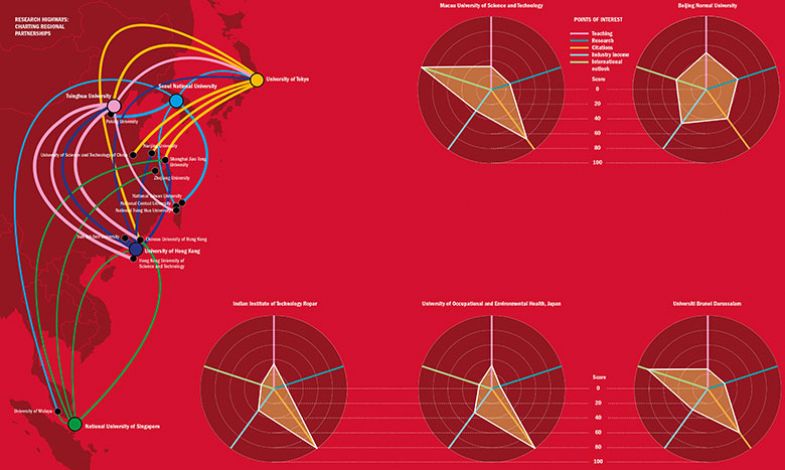Browse the THE Asia University Rankings 2020 results
The new entrants in this year’s Times Higher Education Asia University Rankings demonstrate the diversity of institutions across the continent and highlight that the table does not reward just a single model of excellence.
Almost 80 universities across 21 territories have joined the table this year, and their strengths and weaknesses are as diverse as their countries of origin, as is evident from these “spider” charts. The charts display the scores that the top five newcomer universities achieved on the five pillars underpinning the ranking methodology.
Macau University of Science and Technology, for instance, gains a perfect score for international outlook and is also very strong on citation impact, but it performs much more poorly in the areas of teaching environment, research environment and industry income. Universiti Brunei Darussalam has a similar profile but slightly lower scores.
Elsewhere, the Indian Institute of Technology Ropar and the University of Occupational and Environmental Health, Japan both achieve top scores for citation impact, but have much room for improvement in the four other areas measured, particularly research environment.
In contrast, Beijing Normal University is an all-rounder; it has no notable strengths or weaknesses but achieves modest scores in all five areas.
Meanwhile, the map shows the top regional collaborators for five national flagship universities, based on the number of publications (excluding institutions from within the same territory). The thicker the connecting line, the greater the number of co-authored publications between the two institutions.
The findings reveal that a small group of universities in mainland China and Hong Kong are key collaborators for all the institutions, although South Korea’s Seoul National University is least reliant on these regions and also partners closely with institutions in Taiwan, Malaysia and Japan.
The chart also shows the differing strength of the collaborations. The partnership between the University of Hong Kong and its top regional collaborator (China’s Sun Yat-Sen University) is almost twice as fruitful in terms of article volume as the National University of Singapore’s relationship with its top partner (the Chinese University of Hong Kong).
Register to continue
Why register?
- Registration is free and only takes a moment
- Once registered, you can read 3 articles a month
- Sign up for our newsletter
Subscribe
Or subscribe for unlimited access to:
- Unlimited access to news, views, insights & reviews
- Digital editions
- Digital access to THE’s university and college rankings analysis
Already registered or a current subscriber? Login





